Math 403 diary, spring 2008
In reverse order: the most recent material is first.
I am sorry. I just don't have the time for
this during the current semester. Please see the diary for the previous instantiation of the
course.
go over 1.5 28 in detial, first mapping by z^2 then by exp.
lect 9: go over 1.5 28 in detial, first mapping by z^2 then by exp.
review Green's theorem, do int around unit circle of z-bar then of
z^2. discuss variants. then 1/z first by computing curl, etc.
-->
| Monday,
February 18 | (Lecture #8) |
|---|
More curve words
Line integral
Example?!
Comments, mathwise
Comments, physicswise
ML
Conservative?
Green's Theorem
| Wednesday,
February 13 | (Lecture #7) |
|---|
John von Neuman, a great 20th century mathematician (and one of the
"inventors" of the digital computer), is reported to have said, "In
mathematics you don't understand things. You just get used to them."
ab
If we use the definition
ab=exp(b log(a))=eb log(a) then maybe
some weird things occur. So I computed (1+i)sqrt(2) and
31+i. Even the principal values of these "symbols" are a
bit strange.
sine
I used the equation
ez=ex+iy=ex(cos(y)+i sin(y)) to
motivate the complex analysis definitions of sine and
cosine. So cos(z)=[eiz+e-iz]/2 and
sin(z)=[eiz-e-iz]/2i. I postponed extensive
study of these functions, but briefly noted that, for example, sine
was very different as a complex function. For z real, sin(z) is
our old sin(x), a nice smooth and wiggly bounded function. If
z=iy where y is real, looking at the behavior of sine on the imaginary
axis, sin(iy) is equal to i{sinh(y)}, an unbounded smooth function,
growing very rapidly (exponentially). This can be disconcerting.
Three of the wonderful students in the class volunteered (always
better than the truth, which is closer to were dragooned) to
draw some pictures with me. I only show the results of three of the
students. I set up the exponential function mapping from a domain copy
of C to a range copy of C. Then I stood at the range
copy, with my chalk at w=1, which I also called HOME. I asked each of
the students to choose a value of log(1) different from 0. Since this
is a complex analysis course, there were certainly enough
distinct values to choose from. Each student could have their own
value of log(1). In my head I saw a sort of mechanical linkage reaching
backwards from my 1 to their choices of log(1). The linkage
would "automatically" respond to any changes of position in my
location by moving to nearby places whose value of exp would be where
my chalk moved to. Sigh. There's no pathology in this course:
things will be continuous, things will move nicely, etc. Much more
subtle problems will be met.
The first trip
Then I carefully and slowly (well, almost) moved my chalk from HOME in
a simple closed curve. The curve was made up of circular arcs centered
at the origin and pieces of rays which started at the origin. I used
these curves because last time we had previously computed how vertical
and horizontal lines in the domain were mapped. The inverse images of
my "trip" from HOME to HOME were carefully drawn. They were congruent,
because exp is 2Pii periodic. Each started from each student's
choice of log(1) and returned to that choice.
|
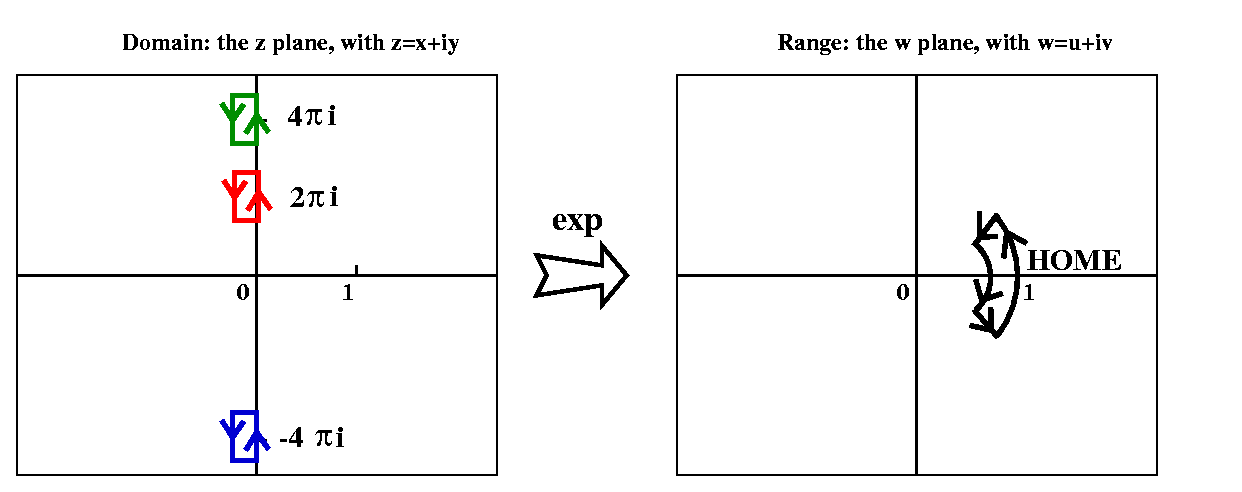
|
The second trip
Well, now I left HOME and traveled in a circle around 0, and returned
to HOME. The students attempted "follow" me in the domain of exp, and
there was some controversy. If we tried to make everything continuous,
then, even though my path in the range was a simple closed curve, each
student draw a path going from one choice of log(1) to another choice
of log(1). This is very, very mysterious.
I drew a few more paths in the range and mentioned what would happen
in the domain, and said we would need to explain all this is great
detail later. This is one of my goals in the course.
|
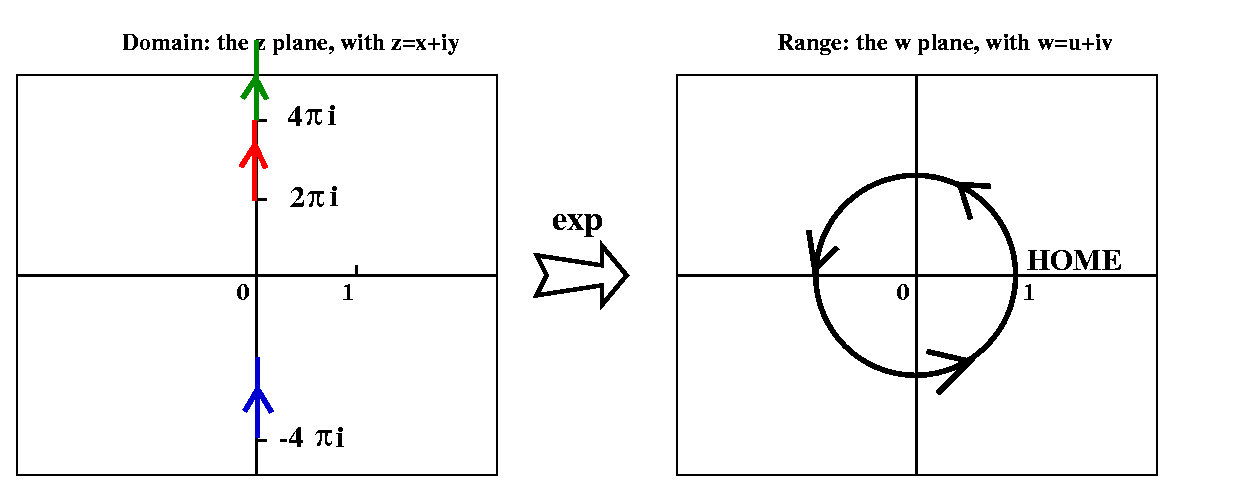
|
The way we will understand the strange behavior just demonstrated,
which has nothing similar in "real calculus" is with curves and
integration around curves. So some more vocabulary lessons are
needed. Most of what's below was done in class, and it is all in the
textbook.
| Phrase | Proper definition | Possible
picture |
|---|
| Curve
| A curve is a function whose domain is an interval, [a,b], in
R, and whose range is in C. If C(t) is the curve, we could write
C(t)=x(t)+iy(t). In this course, these functions will generally be at
least continuous.
| 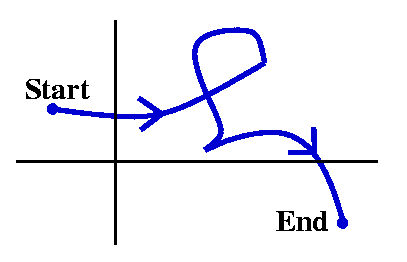 |
| Smooth (differentiable) curve
| C(t)=x(t)+iy(t) should be differentiable, so that x(t) and
y(t) are differentiable. Such a curve has a nice tangent vector at
every point.
| 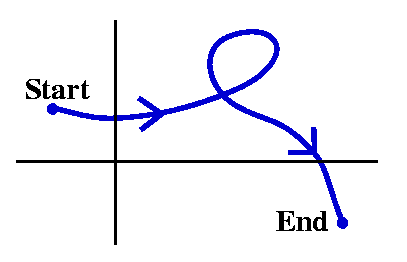 |
| Piecewise smooth curve
| The curve C(t) is certainly continuous. But
additionally, we can divide the interval [a,b] into a finite number of
pieces, and in each of these subintervals C(t) is smooth. This will
allow us to take care of curves with finite numbers of corners, for
example.
| 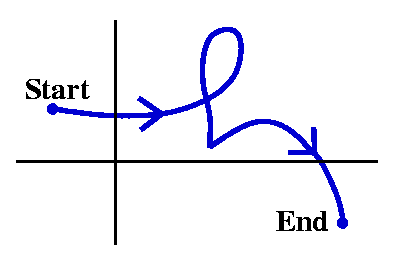 |
| Simple curve
| A simple curve is one which does not intersect itself
except maybe ... at the ends (see the next plus one
definition). So if the
domain of C(t) is [a,b], and if a<s<t<b, then C(s) is
not equal to C(t), and C(a) is not C(s) and C(b) is not C(s).
| 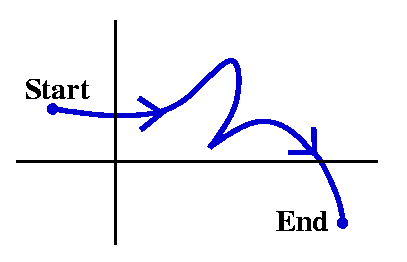 |
| Closed curve
| "Head=Tail" -- that is, if the domain of C(t) is {a,b], then
C(a)=C(b).
| 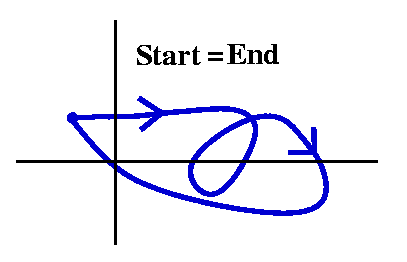 |
| Simple closed curve
| A closed curve which is also simple. Here C(s)=C(t) with
s<b implies either s=t or a=s and b=t.
| 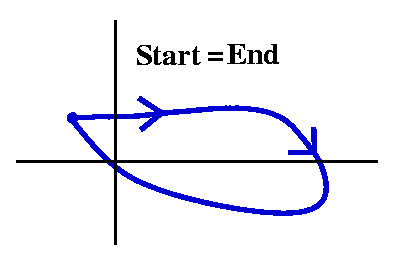 |
| Adding curves | Suppose C1(t) is a curve
with domain [a,b] and C2(t) is a curve with domain
[c,d]. If C1(b)=C2(c) (that is,
C1's "Head"=C2's "Tail", perhaps) then
the curve C(t) whose domain is [a,b+d-c] and defined by
C(t)=C1(t) if t<b and C(t)=C2(t-b+c) (I
hope!) is called the sum of C1 and C2. We
will write C=C1+C2. | 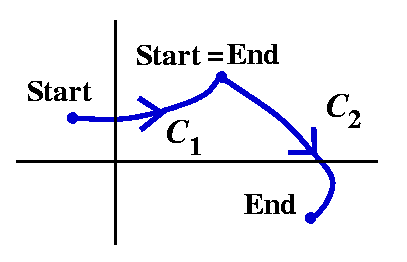 |
| Reversing curves
| If C(t) is a curve with domain [a,b], then the "reversal of
C(t)", also called -C, will be the curve, let me temporarily
call it D(t), whose domain will also be [a,b], defined by D(t)=C(b+a-t).
-C is just C backwards. The picture is slightly weird (how
should I have drawn it?) but I hope you get the idea.
| 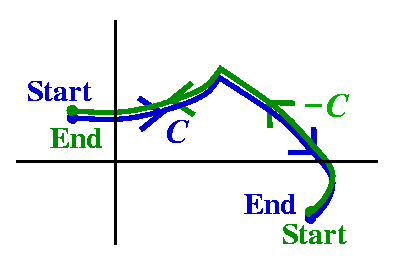 |
I hope the darn formulas for C1+C2 and -C(t) are
correct. I don't think I will ever be so formal again in this
course. I will usually be rather casual. The curves in this course
will all be piecewise differentiable, and, actually, they will turn
out to be sums of line segments and circular arcs: HAH! to general theory!
Actually I should acknowledge that what we are defining are called
parameterized curves. For example, the curves C(t)=t and
C(t)=t2 (use [0,1] as domains in both cases) are really
different, even though they "look" the same. It turns out that we will
mostly be interested in line integrals and a remark below about the
values of the integrals explains why we will not care about
different parameterizations.
A few examples
This curve is a straight line segment starting at -4i and going to
-2i, followed by a quarter circle whose center seems to be 0,
starting at -2i and going to 2.
If I wanted to be totally strict, I guess I could define a C(t) on the
interval from [0,2+(Pi/2)] Let's see: for t in [0,2), let C(t) be (t-4)i,
and for i in [2,2+(Pi/2)], define C(t) to be
2ei(t-2-(Pi/2)).
Some remarks Almost always in this course I will parameterize
circles and circular arcs using the complex exponential. My first
guess will always be
CENTER+RADIUSei(stuff).
Another remark: what I've just done is excessively precise and maybe
slightly silly. I want to write curves in a way that is convenient. So
this curve should be written as a sum of two curves, say
C1+C2. Here C1(t)=ti where t is in
the interval [-4Pi,-2Pi], and C2(t)0+2eit where
t is in the interval [-Pi/2,0]. It is just easier to do this than to
try to figure out the total length, how to combine and adjust
parameterizations, etc.
| 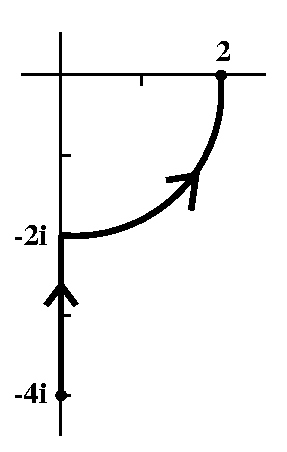 |
Here I will write the curve again as a sum,
C1+C2. C1 seems to be a semicircle of
radius 2 and center -1. It goes backwards. So
C1(t)=-1+2ei([Pi]-t) where t is in the interval
[0,Pi]. C2 is a straight line segment. This I know how to
parameterize from thinking about
convexity. C2(t)=t(1)+(1-t)(-3i) where t is in the
interval [0,1].
A remark Parameterizing a circular arc in a clockwise fashion
feels close to obscene to me. Almost always in this course our circles
will be parameterized positively, which will mean
counterclockwise.
| 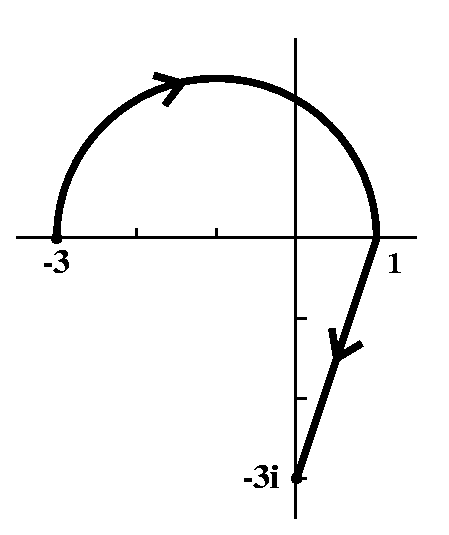 |
| Monday,
February 11 | (Lecture #6) |
|---|
Grading, syllabus, etc.
I will attempt to cover most of chapters 1, 2, and 3, and some of
chapter 4 of the text. Grades will be based on inclass exams (100
points each), announced at least a week in advance (if at all
possible!) and a final exam (200 points) and homework and other
considerations (100 points or so for homework, and up to 50 points for
"other", depending on what is done).
Continuity
We have some experience now about complex sequences and when they do
and do not have limits. Continuous functions behave well with
respect to limits. What do I mean? If D is a connected open set in C
(a domain) and if f is a complex-valued function defined on D,
then f is callled continuous when the following statement is
true:
If {zn} is any sequence in D
which converges to some number w in D (so
limn-->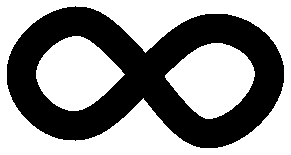 zn=w)
zn=w)
then the sequecne {f(zn} also
converges, and its limit is f(w) (so
limn--> zn=f(w).
zn=f(w).
This is a complicated quantified statement again, but it is merely a
reproduction of what goes on with real functions in calc 1. I'd like
you to be as comfortable with it as you were back then. I am ashamed
and amused to declare that this also will not be a central issue of
the course.
We know from last time that limn--> zn=w
exactly when both the real and the imaginary parts of the
sequence have real limits which are, respectively, the real and
imaginary parts of w. Therefore, if f(z)=f(x+iy)=u(x,y)+iv(x,y) (these
are the usual names for the real functions u and v which are the real
part of f and the imaginary part of f) then f is continuous exactly
when u and v are continuous (as real functions)>
zn=w
exactly when both the real and the imaginary parts of the
sequence have real limits which are, respectively, the real and
imaginary parts of w. Therefore, if f(z)=f(x+iy)=u(x,y)+iv(x,y) (these
are the usual names for the real functions u and v which are the real
part of f and the imaginary part of f) then f is continuous exactly
when u and v are continuous (as real functions)>
Some examples
zn, where n is a positive integer, is a continuous
function. If I had to prove this, then I might think about the
following: zn=(x+iy)n=[use the Binomial Theorem
a lot, and pull apart the terms with the i's and the terms without the
i's]a real polynomial in x and y + i
multiplied by another real polynomial in x and y. For example,
consider
z3=(x3-3xy2)+i(3x2y-y3). And
each of the polynomials is continuous, so zn is continuous
in all of C.
Another example mentioned was (3z+2)/(z2+1). Here something
interesting does happen. The function when restricted to the real line
(so think of z replaced by x, a real number) is
(3x+2)/(x2+1). We discussed briefly what the graph of this
real function would look like. It would be defined everywhere, and
easy calc 1 would allow use to sketch it. But the function
(3z+2)/(z2+1) is defined on all of C except
+/-i. This is C with two holes. It turns that that the vital
information telling you how to think about this complex-valued
function occurs near the two holes! Notice that C with +/-i taken out
is a connected open set.
|z| is a function which is continuous on C: no restrictions.
Most things are ...
Most of the functions we will consider will be continuous
(polynomials, rational functions where they are defined, the
exponential function [see below], etc.). Continuity will not be a
major problem or central consideration of the course.
A special example
There is one function which was mentioned specially, and which has no
simple counterpart in real calculus. First, consider arg(z). If z is a
non-zero complex number, then arg(z) is any real number which
makes the equation z=|z|(cos(arg(z))+isin(arg(z)))
correct. A simple picture (already drawn in this diary several times!)
should convince you that there are such numbers. In fact, there are
infinitely many numbers which can serve as arg(z) since sine
and cosine are 2Pi-periodic. arg(z) therefore specifies an
infinite collection of numbers for each non-zero z. There is a
unique number which can serve as arg(z) inside any interval of length
2Pi. That is, if you specify A, and we then search the interval
[A,A+2Pi), exactly one number in there will be a valid arg(z). Most
people would like to know a specific value of arg in order to compute
efficiently. But, hey, we could specify A=1010 or
A=-117. Neither of these are used. The most commonly used values of A
are 0 and -Pi. Our text uses A=-Pi, and calls the unique value of
arg(z) which is in the interval [-Pi,Pi), Arg(z), with a capital A.
So while arg(1+i) is the collection of numbers {Pi/4, 9Pi/4, -7Pi/4,
17Pi/4, -15Pi/4, ...} the number Arg(1+i) uniquely specifies Pi/4. And
Arg(-1-sqrt(3)i) is uniquely -2Pi/3 (if I am imagining the triangle
correctly!). The only numbers which have Arg(z)=0 are the positive reals.
Level curves of Arg
The picture below shows some level curves of Arg. Notice that the
origin has no value for Arg. Each of the level "curves" is a
ray, a half line, starting from the origin (but not including it!). So
Arg is a peculiar function. The last level set is actually empty!

The specific A chosen in the text (so [-Pi,Pi) contains all of Arg's
values) is so that Arg will be continuous near points on the positive
real axis.
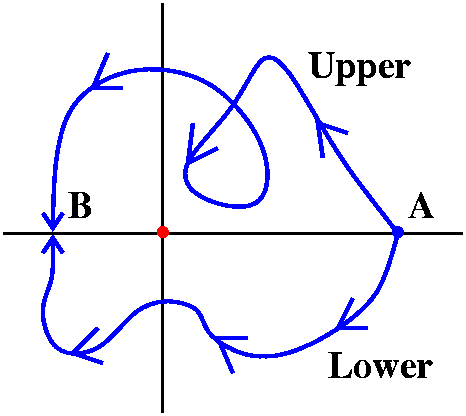
Suppose A is a point on the positive real axis. Then near A, Arg will
vary continuously. Points near A in the upper halfplane will have Arg
values near 0 and positive, and those near A in the lower halfplane
will have Arg values near 0 and negative. Suppose, though, we try to
move farther away. Look at the two parts to the right. On the Upper
curve, the values of Arg will increase (except around the loop!) and
especially as the Upper curve points near B (on the negative real
axis), they will increase to Pi. What happens on the lower loop? There
the values of Arg will descrease, and as the points move (?) towards
B, the values of Arg will tend to -Pi. So Arg is actually not
continuous at B. Depending on the direction of approach, there may be
a jump of 2Pi in Arg's value. So:
Arg is not continuous at any negative real number, and at such
a number, Arg has a jump discontinuity of magnitude 2Pi.
The subject is dichotomous (?)
One dictionary definition of the $5 word is "Dividing into two equal
branches". I'm being a little bit silly, but complex variables sort of has:
Lovely general theorems and Examples with huge information
density.
Of course the theorems don't mean much without really good examples,
and the examples are sort of difficult to understand without the
theorems which organize them, but ... many people would agree. Let's
try to study a very important example.
The single most important function
What should the exponential function be?
- Certainly exp(0)=1.
- I think
exp(z1+z2)=exp(z1)exp(z2)
for all possible complex z1 and z2.
- When we've got a good theory, certainly exp should be
differentiable, and exp´(z) should be exp(z).
These attributes are not logically independent. A good calc 1 textbook
will substantiate the following: any differentiable function
satisfying A and B together must satisfy C, while any function which
satisfies A and C must satisfy B. A, by the way, is almost decoration
-- it just gives an initial value for the function. Thus B and C are
nearly equivalent. I would be happy to discuss these implications with
you if you really want.
The textbook asserts that
exp(z)=exp(x+iy)=excos(y)+iexsin(y).
What is and what should be the exponential function
Here is one heuristic way of seeing why the definition is
"correct". Here "heuristic" means "allowing or assisting to discover."
It turns out (you will see) that everything I'm doing can be made
(terrifically!) rigorous. BGut this is a way of seeing why
people use this strange definition.
If exp(z)=exp(x)exp(iy), then we just need to understand
exp(iy). If f(y)=exp(iy), then f(0)=exp(0)=1. Also, if
we believe in the chain rule, f´(y)=exp´(iy)i,
and then
f´´(y)=exp´(iy)i2=-exp´(iy). So
f(y) is a function which is minus its own second derivative, and we
have the initial conditions f(0)=1 and f´(0)=i. Well, we
know from our differential equations course that any function which is
minus its second derivative is a linear combination of sine and
cosine, so exp(iy) must be Acos(y)+Bsin(y) for some A and
B. The initial conditions allow us to conclude that A=1 and
B=i.
How to compute it
Notice please that this function is made of sums and products of
well-known functions which are certainly continuous, and therefore it
is nice and continuous, also. I can compute e3+2i because I
can compute e2 and cos(2) and sin(2) and then combine them
appropriately.
Periodicity>
The most shocking thing about the exponential function is that it is
periodic. Since eiy is cos(y)+isin(y), changing y by an
integer multiple of 2Pi won't change eiy. Therefore, for all z,
ez+(2Pi)i=ez. (!)
Solving ez=w
If ez=w, then ex+iy=s+it, so
excos(y)=s and exsin(y)=t.
Therefore we deduced that w cannot be 0 (or else either
ex=0 [impossible!] or both sin and cos of y would be 0
[impossible, since sin2+cos2=1]). If w is not 0,
then we got solutions of ez=w (the instructor fouled this
up beautifully in class!): x=ln(|w|) and y=arg(w). For non-zero w,
(not surprisingly) a solution of ez=w is called log(w). If
y=Arg(w), then the solution is called Log(w) (note the capital
letter!).
Some pictures
The following material is taken from the previous instantiation of the
course. What was done was much like this.
The complex
exponential function has many pleasant and some irritating aspects. It
is a bit difficult to draw a true graph of this function. The
domain points are in C which is R2, as are the range
points. Therefore the graph, the pairs of points (z,ez)
would be elements of R4, and I don't know any neat ways of
showing four-dimensional graphs. (Many attempts of been made. For
example, we could sketch (x,y,u(x,y)) and change this standard graph
of a surface in R3 to the graph (x,y,v(x,y)) by some
geometric process. Or one could "draw" the graph of u(x,y) and put
colors on the graph according to the values of v(x,y). You can easily
find these methods and others on the web. I'll stick to more ordinary
methods here.
|
I'll have a complex plane representing the domain to the left, and
then a range complex plane to the right. I'll try to sketch objects on
the left in the domain and then sketch the corresponding objects on
the right, objects which "correspond" under the exponential mapping.
|
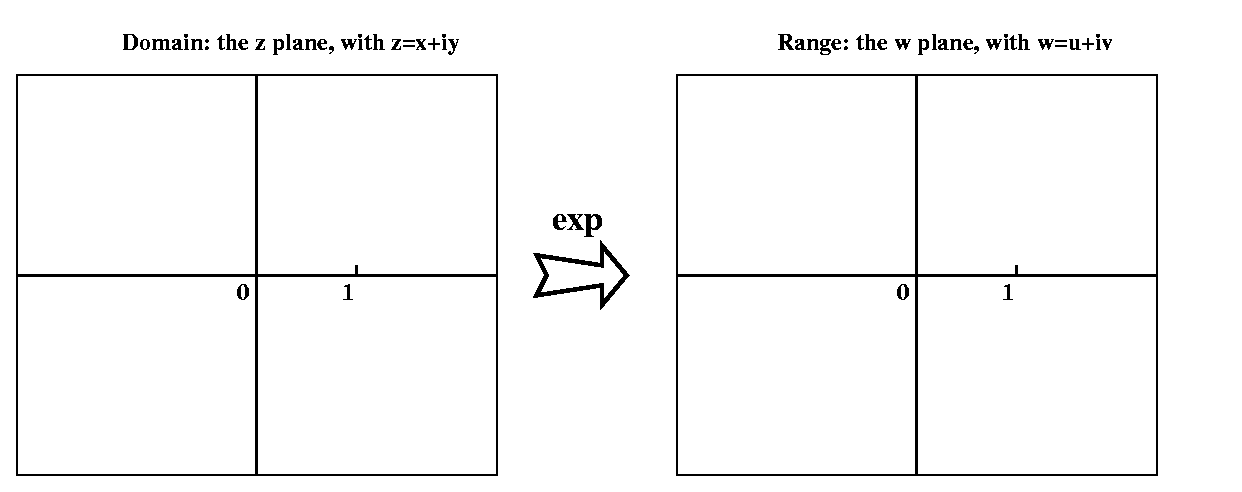
|
One horizontal line
Consider the horizontal axis. We could image a bug moving on the axis
in the domain at uniform velocity, from left to right. Here y=0, and x
goes from -infinity to +infinity. The image in the w-plane is
excos(0)+iexxsin(0) which is just
ex. Notice that this is a ray, a halfline, whose
image covers the positive x-axis. The image of uniform motion is no
longer uniform motion. Near "-infinity" the image bug moves very
slowly, and as the image goes from left to right along the positive
x-axis, the image bug moves ever faster, exponentially faster.
|
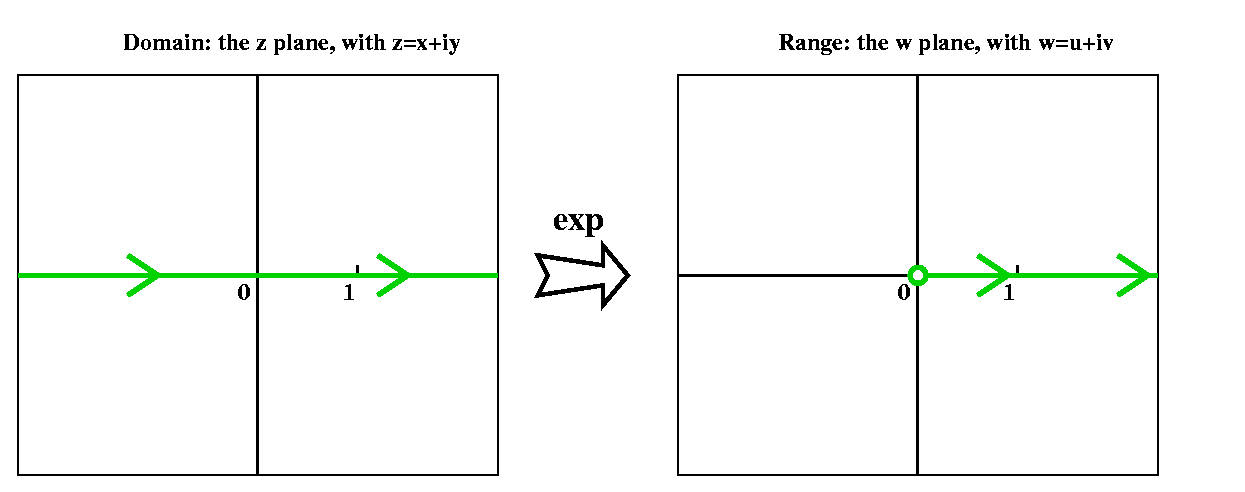
|
One vertical line
Now consider the vertical imaginary axis, where x=0, and a bug
crawling at uniform velocity from -infinity (in y) to +infinity (in
y). Now with x=0, the image is
e0cos(y)+ie0sin(y). So the image is the unit
circle, described in the positive (counterclockwise) fashion, with the
circle drawn at uniform velocity (1 radian per timestep).
|
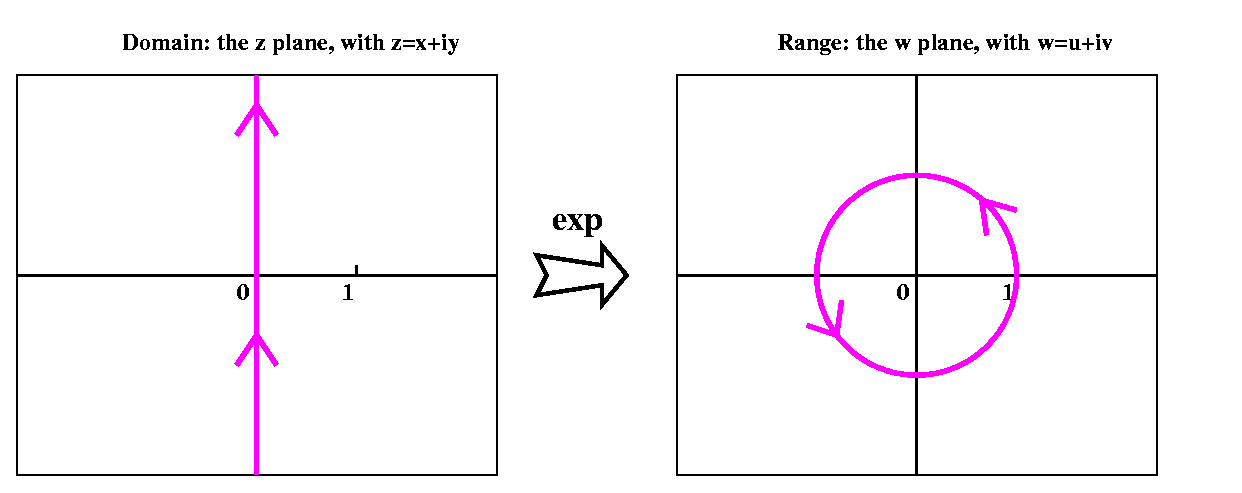
|
Other horizontal lines
If we look for the image of a horizontal line which is just slightly
above the x-axis, what will we get? Here we have
excos(y)+iexsin(y) with y a small
positive number. In fact, in terms of vectors, this is all positive
(ex) multiples of the unit vector [cos(y),sin(y)]. So the
image is again a halfline, a ray, emanating (originating?) from 0 at
angle y to the positive x-axis. You could imagine as the horizontal
lines go up or go down, the images will rotate around the origin.
|
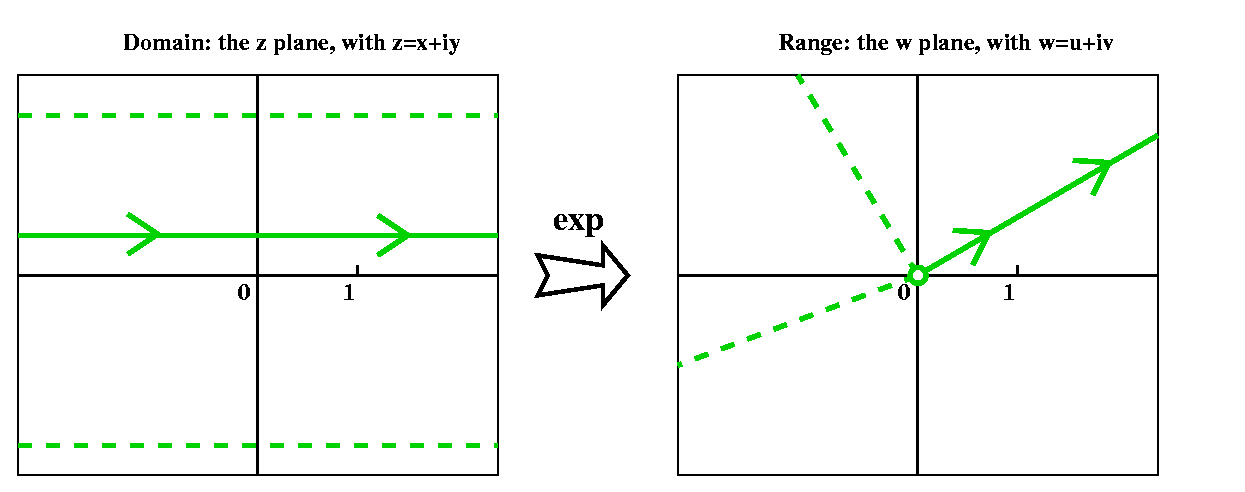
|
Other vertical lines
If we look for the image of a vertical line which is to the right of
the y-axis, what will we get? Here we have
excos(y)+iexsin(y) with x a positive
number. In fact, this describes a circle whose center is the origin,
and whose radius is ex, always a positive real number. You
could imagine as the vertical lines go left or right, the images will
all be circles centered at the origin of varying radii.
|
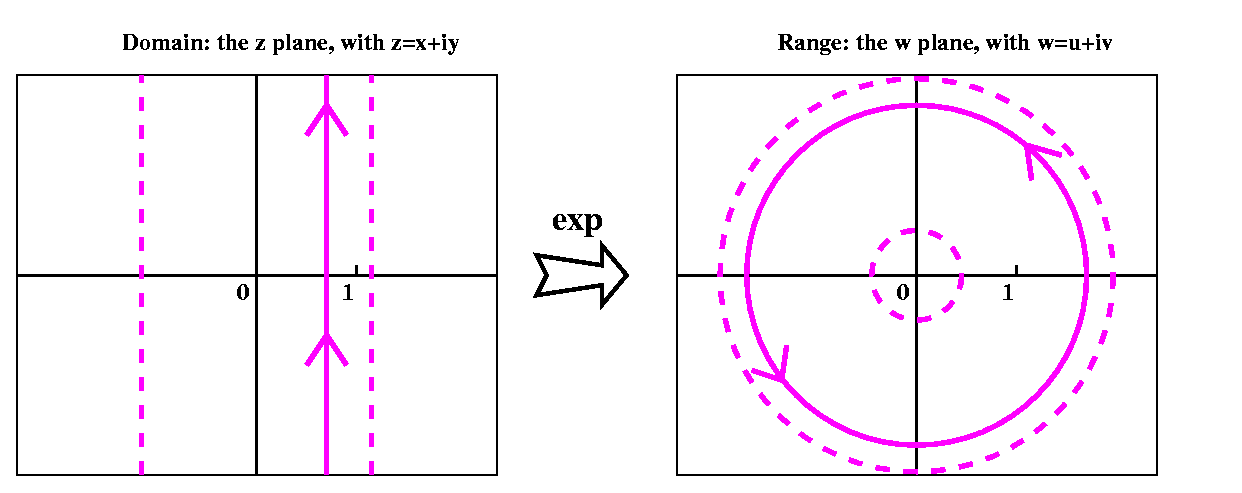
|
We even briefly consider an oblique line, and decided that its image
was a spiral.
| Wednesday,
February 6 | (Lecture #5) |
|---|
A detailed proof of the following Theorem was given:
If limn--> zn=T1 and if
If limn-->
zn=T1 and if
If limn--> zn=T2 then
T1=T2.
zn=T2 then
T1=T2.
This is too much abstraction for (my version of) Math 403. At the same
time, we discussed solutions to the workshop given last time
(solutions are available here). One answer given by several
teams to the question, "Is A an open set? Give some brief explanation"
was something like: "An open set has an open disc around each of its
points contained entirely in the set." This sort of answer is not
adequate. It can be read as merely a parroting, a repetition without
further understanding, of the definition. An adequate answer would
have some recognition of the specific set A. It would contain words or
a useful appropriately general picture or computation -- something
which might convince a reader that those writing the "explanation"
understood how the definition applied in this specific context.
This was my attempt to try to show people what sorts of written
responses I would find useful and credible.
Convergence
We reviewed convergence. The complex idea of convergence is "just" (?)
an abbreviation for the real sequences made of the real and imaginary
parts of the original sequence converging. Some examples were given.
Series
Both series and convergence of a series were defined, the latter in
terms of the limit of the sequence of partial sums. Again, this is a
notion which (with real and imaginary parts) is "just" two real series
converging. The idea of an absolutely converging series was defined,
and reference was made to real calculus to prove (in the
context of this semi-rigourous, fairly heuristic course) that
absolutely convergent series of complex numbers must converge. A few
examples were given.
Geometric series
The formula for the partial sum of a geometric series was
deduced. Then there was analysis of the behavior of the sequence
{rn}, where r was a complex number. Quite easily we saw
that if |r|<1, this sequence converges with limit=0. If |r|>1,
the sequence diverged (or, maybe, in the Riemann sphere sense, it
converged [!] to  ). When r=1 the
sequence converge, but there was divergence for other values of r with
|r|=1 (the divergence behavior is rather different if r is a rational
multiple of Pi and if it is not: we drew some pictures).
). When r=1 the
sequence converge, but there was divergence for other values of r with
|r|=1 (the divergence behavior is rather different if r is a rational
multiple of Pi and if it is not: we drew some pictures).
The Magic Frog
We analyzed the destination of a Magic Frog, who starts at the
origin, and then leaps 1 unit right. It makes a left turn (Pi/2) and
leaps 1/2 unit. Then makes a left turn (Pi/2) and leaps 1/4 unit,
etc. This was a geometric series with first term 1 and ratio i/2. We
found the sum and the real and imaginary parts of the sum, the
limiting position or destination of this Magic Frog.
Continuity
The word "continuous" was mentioned. Functions with this attribute
take convergent series in the domain to convergent series in the
range. Certainly more needs to be said. Please read the textbook.
| Monday,
February 4 | (Lecture #4) |
|---|
Vocabulary
We discussed these words in detail with a bunch of examples:
open, closed, connected, domain, boundary.
Lots of examples, etc. Nomination by the instructor for worst
mathematical terminology (in English and other languages!): open and closed since there
are sets which are neither closed nor open. The lecturer even asked
how many line segments a polygonal path had to have. I think it went
like this: what is the maximum of the minimum number of line segments
connecting any two points in a connected open set? For a disc, that's
1. We were able to create connected open sets where this was any
positive integer, and, indeed, even connected open sets where it was
infinite! So then we were able to have a
Workshop
!? The lecturer served as peer mentor (!) and gently strolled around
the intensely concentrating students, and with great warmth supplied
help. Here is the text of the
workshop.
Sequence and limit
We defined the limit of a sequence, and proved that one sequence could
not converge to both +i and -i. We need to say more about this.
| Wednesday,
January 30 | (Lecture #3) |
|---|
An over- and underestimate (Ralph again)
We did something like this (actually, the volunteers,
Mr. Kulkarni and
Mr. Mallett, did the work, which we
then admired):
If |z|=3, find useful over- and underestimates of
|(7z-1)/(2z2-7)|.
How to do it Find over- and underestimates for the Top and the
Bottom separately using the triangle and reverse triangle
inequalities.
Top: |7z-1|<=7|z|+|-1|<=7(3)+1=22. Also, |7z|-|-1|<=|7z-1|,
so that 20<=|7z-1|.
Bottom:
|2z2-7|<=2|z2|+|-7|=2|z|2+7=18+7=25.
And |2z2|-|-7|<=|2z2-7| so that
18-7<=|2z2-7|.
Therefore we know the following:
20<=Top<=22
11<=Bottom<=25
What can we conclude about Quotient=Top/Bottom? To overestimate a
quotient, we must overestimate the top and underestimate the
bottom. The result is that Quotient<=22/11. For an underestimate
of a quotient, we need to underestimate the top and overestimate the
bottom. So 20/25<=Quotient.
The homework problem (several solutions)
I had asked people to show that the "mapping" z--->i(1-z)/(1+z)
takes points in D1(0), the unit disc, the inside of the
unit circle, to H, the upper half-plane, those z's with
Im(z)>0. Mr. McGuirk bravely
computed with z=a+ib (a and b real numbers with
a2+b2<1. Mr. Ratner did a more "complex" (?)
computation, and used z and z–. Both were very
nice. Then I solved i(1-z)/(1+z)=w for w, and I remarked that this
"mapping" would actually take H back to D1(0), and this
could be algebraically verified in a very similar manner (the mappings
are 1-1 and onto: bijections, if you know the word). So somehow
D1(0) and H are the
same. In fact, I even mentioned that the mappings back
and forth preserve angles between curves, which is not at all obvious.
What is really going on?
From my point of view these two sets, one of which is the inside of a
circle and very "finite" with a curvy boundary, and other of which is
an infinite half plane with a very straight boundary, are really the
same. Let me try to explain why.
The Riemann sphere and stereographic projection
 One geometric way to visualize what is going on uses stereographic
projection. Put the complex plane into space (R3) as
the xy-plane, with third coordinate equal to 0. Draw a sphere with
radius 1 and center the origin, (0,0,0). Let N, the North Pole, be
located at (0,0,1). Then every point a on the sphere which isn't N
corresponds to a unique point b on the complex plane. The
correspondance is by drawing a line from N to a and extending it until
it intersects the plane. The intersection point is called b. Of
course, we could start with b on the complex plane, and connect it
with N, and the line would always hit the sphere in some other point,
a. This "correspondance" is a useful thing to keep in the back of your
mind (?) throughout your study of the subject. Of course you can write
lots and lots of equations describing everything, but right now I just
want the idea, without proofs or whatever. In fact, it turns out that
stereographic project also "preserves angles" between corresponding
curves (this is not immediately obvious at all).
One geometric way to visualize what is going on uses stereographic
projection. Put the complex plane into space (R3) as
the xy-plane, with third coordinate equal to 0. Draw a sphere with
radius 1 and center the origin, (0,0,0). Let N, the North Pole, be
located at (0,0,1). Then every point a on the sphere which isn't N
corresponds to a unique point b on the complex plane. The
correspondance is by drawing a line from N to a and extending it until
it intersects the plane. The intersection point is called b. Of
course, we could start with b on the complex plane, and connect it
with N, and the line would always hit the sphere in some other point,
a. This "correspondance" is a useful thing to keep in the back of your
mind (?) throughout your study of the subject. Of course you can write
lots and lots of equations describing everything, but right now I just
want the idea, without proofs or whatever. In fact, it turns out that
stereographic project also "preserves angles" between corresponding
curves (this is not immediately obvious at all).
Comment The stereographic project shown here is what's usually
done now. But there is another common variant, where the sphere is
"balanced" on top of the plane, so its center is at (0,0,1) and the
North Pole is at (0,0,2).
Now back to D1(0) and H
We then struggled to see what happens to the unit disc. It corresponds under stereographic projection to the lower half of the sphere. We could then rotate the sphere and make the lower half into the "back" half. This then corresponds to H, the upper half plane. So: we see that D1(0) and H are the same.

We will see ...
We will see other and faster ways to verify these results. But you may
as well see now some of what we're heading for. I also noted that N,
the North Pole, frequently has another name in the theory. You can
think of it as infinity because all of the points close
to it on the sphere correspond to numbers in the complex plane which
are really big.
Open disc
An open disc is a collection of complex numbers specified by an
inequality of this kind: |z-a|<r where a is a complex number (the
center of the disc) and r is a positive real number (the radius
of the disc). I will try to call this collection of numbers
Dr(a). The book doesn't seem to have a specific notation
for it. I will try to be consistent. So we looked at
D1(0). We could consider D1(i) and
D2(2). Here are pictures of all of these, on separate
"copies" of the complex plane.

The circles in the picture are dashed to be sure that you realize
they are not part of the open discs. They
are the boundaries of the discs.
Open set
An open set is a generalization of the concept of open
disc. Here is the definition: a subset U of C is called open
if, for every z in U, there is r>0 so that the open disc
Dr(z) is contained entirely in U.
Warning!!! Veterans of Math 300 will
already feel the scars inside their brains twitch: this is a
quantified expression. Other experienced consumers (?) of math
will also be a bit hesitant. But novices may need some help. So let's
get some examples.
Examples
- Suppose we try just C itself. In fact, golly, D1(z)
is inside C (that's not too difficult, all the darn complex numbers
are in C). So C is open.
- What if I tell you that I'm thinking of an open set which has a
disc of radius 1 centered at any point in it contained in it?
There is some logicial puzzle here. But I hope you can see that such a
set would have to be all of C. In fact, fix some number
r>0. If we think of "an open set which has a disc of radius r centered at any point in it contained in
it" -- well that will have to be C, also!
- The r in the definition actually may depend on the specific z. In
fact, consider D1(0), the open unit disc. Open discs should
be open sets -- the open sets are generalizations of open discs. But
the number 3/4 is in D1(0), and the only eligible r's for
which Dr(3/4) is contained in the unit disc have r at most
1/4. And if we choose something closer to the boundary (we'll define
"boundary" precisely soon) like .99i, well, the r's so that
Dr(.99i) are contained in D1(0) are those r's
with r<=.01. So r will depend on z in general. For the veterans of
a proof course, realize that the phrase "for every z in U, there is
r>0" means Upside down A z in U Backwards E r>0. So
there. I will not be so symbolically precise, but the ideas will be
needed.
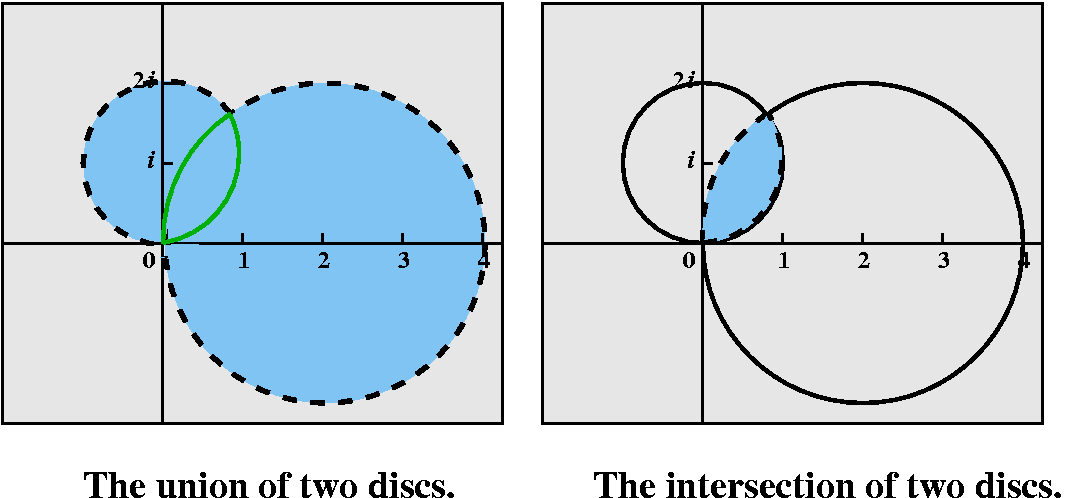
-
The intersection of two open discs is open (z's which are in
both of the discs), and so is the union (z's which are in at
least one of the discs). Two brave volunteers came to the board and
drew their pictures. We discussed what was in these sets.
I still don't know where the other cusp or corner of the lune (area
between two circular arcs) is. The verification (proof!) that
the union or intersection of two open discs is open is not difficult
(the minimum of the two r's will work for either of the sets) but I
don't think I'll need to prove such things in this course. I would
like you to recognize open sets, though.
Connected open set
Open discs will turn out to be convenient for many purposes, but we
will knit together open sets by taking unions of them. I draw what may
seem like silly examples of open sets, two "chains" of
discs. Actually, these chains of discs have important computational
importance, as you'll see later. I noted that the two examples I drew
both had the following properties:
If you take any points p and q in each of them, you can draw a
polygonal line connecting the two points which lies entirely inside
the set. However, for the two chains of discs I drew, the
intersection, which is an open set consisting of two "lunes" has the
following property: you can choose points p and q in the set so that
there is not polygonal line lieing entirely in the set
connecting the two points.

Open sets which have the property that any two points can be connected
by a polygonal path entirely in the set are called
connected. Otherwise they are not connected or (sometimes said)
disconnected.
| Monday,
January 28 | (Lecture #2) |
|---|
The lecturer, monstrously unprepared, decided to do what all
instructors do when unprepared: review what was already done (how much
time can be spent reviewing when the course has scarely
begun?).
So let's write again the important pictures:
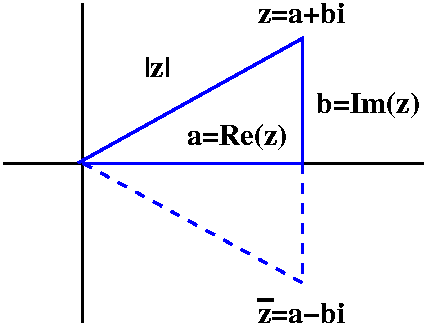 | 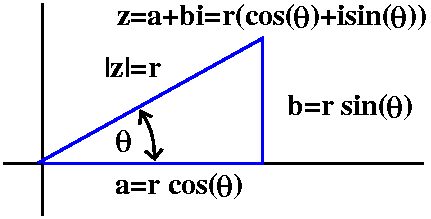 |
And now a summary of some facts:
-
z=a+b i with a and b real mean that a=Re(z)
and b=Im(z).
-
If w=c+d i with c and c real, then a+c=Re(z+w) and b+d=Im(z+w).
-
z–=a-b i, the complex
conjugate.
- (z–)–=z and
(z+w)–=z–+w–
and (z·w)–=z–·w–.
-
Re(z)=(z+z–)/2 and Im(z)=(z-z–)/(2i).
-
|z|=sqrt(z·z–) (here
by sqrt is meant the unique real non-negative square root of a real
non-negative number).
- Also |a|<=|z| and |b|<=|z| (easy: sqrt is increasing, so
|a|=sqrt(a22+b2)=|z|).
- |z|<|a|+|b|. (As a student pointed
out, this is a simple version of the triangle inequality applied to
the sum a+b i, which we discussed later. My response is that this
is a very simple version, since I know
|z|2=a2+b2<=a2+2|a|·|b|+b2=(|a|+|b|)2,
and we can then take square roots).
-
If z=r(cos(
 )+i sin(
)+i sin( ) then r=|z| and
the other part is a complex number of modulus 1 (it is on the unit
circle, the circle of radius 1 centered at 0).
) then r=|z| and
the other part is a complex number of modulus 1 (it is on the unit
circle, the circle of radius 1 centered at 0).
-
If z is not 0,
 is a value of arg(z), a number which is
defined up to an integer multiple of 2Pi (usually the argument of 0 is
not defined). Also, arg(z–)= -arg(z).
is a value of arg(z), a number which is
defined up to an integer multiple of 2Pi (usually the argument of 0 is
not defined). Also, arg(z–)= -arg(z).
- arg(zw)=arg(z)+arg(w) (where here
"=" means that there may be an integer multiple of 2Pi difference
between the sides).
My opinion is that you should not try to "memorize" all of
these rules, since we will be using them constantly and, if you attend
the lectures, read the textbook, and do the homework problems, then
you will surely learn (internalize?) all of these.
Understanding De Moivre
This result is (cos( )+i sin(
)+i sin( ))n=cos(n
))n=cos(n )+i sin(n
)+i sin(n when n
is an integer. I wanted to use it.
when n
is an integer. I wanted to use it.
Roots of a polynomial
Certainly if x is real, the equation x3=1 has exactly 1
root (I think 1 is that root!). But "high school algebra" sort of
implies that polynomials should have as many roots as the degree of
the highest order monomial (with non-zero coefficient!). O.k.: we may
have to worry about "multiplicity" if several roots are equal. But,
anyway, the equation should have three roots.
What if z=r(cos( )+i sin(
)+i sin( )) and z3=1? Well, 1=cos(0)+i sin(0),
and DeMoivre implies that z3=r3(cos(3
)) and z3=1? Well, 1=cos(0)+i sin(0),
and DeMoivre implies that z3=r3(cos(3 )+i sin(3
)+i sin(3 )). Since the moduli (moduluses?) should be equal, we
know r3=1 where r is a non-negative real number, so r must
be 1. But what about the arguments? I do know that 3
)). Since the moduli (moduluses?) should be equal, we
know r3=1 where r is a non-negative real number, so r must
be 1. But what about the arguments? I do know that 3 and 0 should be the "same
argument". But what does that mean? 3
and 0 should be the "same
argument". But what does that mean? 3 =0+2Pi(integer) so that
=0+2Pi(integer) so that  =2Pi(integer)/3. How many complex numbers are there which
agree with this specification? Well, try integer=0 and 1 and 2. Other
integers will result in an argument which, "mod 2Pi", is the same. But
those three values give us distinct z's.
=2Pi(integer)/3. How many complex numbers are there which
agree with this specification? Well, try integer=0 and 1 and 2. Other
integers will result in an argument which, "mod 2Pi", is the same. But
those three values give us distinct z's.
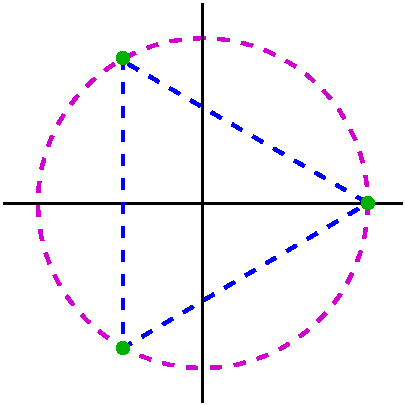
Let's see: so there are 3 distinct complex numbers, r0 and
r1 and r2, which have the property that their
cube is 1. Since we "happen" to know certain values of sine and
cosine, we could actually explicitly describe these numbers in terms
of their real and imaginary parts (actually I personally like the
polar descriptions more for reasons which will become clear very
soon). So:
r0=1+0 i and r1=(-1/2)+i sqrt(3)/2 and
and r2=(-1/2)-i sqrt(3)/2.
Since there were doubters (including the lecturer!) I checked:
(r1)2=((-1/2)+i sqrt(3)/2)2=1/4-i(2)(1/2)sqrt(3)/2-3/4=-1/2-i sqrt(3)/2. This
happens to be, by the way, both r2 and the complex
conjugate of r1. Therefore when it is multiplied by
r1 (to get (r1)3) the result is
|r1|2 which is certainly 1.
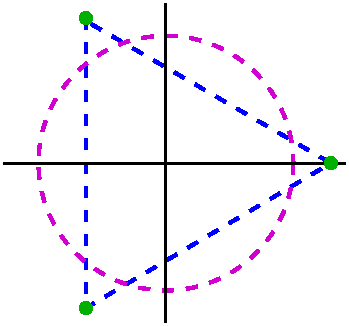 So we have
three distinct roots of the equation z3=1, and they form an
equilateral triangle centered around 0. I asked if we could get roots
of z3=2, say. After some thought, we decided that we knew
one "real" root, 21/3, and then we can get others. A
complete set of roots turns out to be 21/3r0 and
21/3r1 and 21/3r2. This is
also an equilateral triangle around 0. To the right is a picture of
them. The real number whose cube is 2 is about 1.26, so the unit
circle is inside the "radius" of all of the roots of 2.
So we have
three distinct roots of the equation z3=1, and they form an
equilateral triangle centered around 0. I asked if we could get roots
of z3=2, say. After some thought, we decided that we knew
one "real" root, 21/3, and then we can get others. A
complete set of roots turns out to be 21/3r0 and
21/3r1 and 21/3r2. This is
also an equilateral triangle around 0. To the right is a picture of
them. The real number whose cube is 2 is about 1.26, so the unit
circle is inside the "radius" of all of the roots of 2.
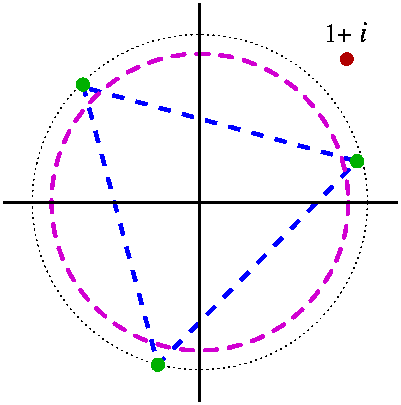 Finally I
asked if we could "solve" z3=1+i. Well, in polar form 1+i
is sqrt(2)(cos(Pi/4)+i sin(Pi/4)). I will guess (not
really -- I am being guided by previous computations) one cube root of
1+i. If z=r(cos(
Finally I
asked if we could "solve" z3=1+i. Well, in polar form 1+i
is sqrt(2)(cos(Pi/4)+i sin(Pi/4)). I will guess (not
really -- I am being guided by previous computations) one cube root of
1+i. If z=r(cos( )+i sin(
)+i sin( )) then the modulus of z3 would have to be
sqrt(2), so r should be 21/6 (this is a real positive
computation, the cube root of the square root of 2!). And one
)) then the modulus of z3 would have to be
sqrt(2), so r should be 21/6 (this is a real positive
computation, the cube root of the square root of 2!). And one  which would make things work would
be Pi/4 divided by 3, which I think is Pi/12. I don't
offhand know the sine and cosine of that number, which is o.k., but
let's call q the complex number
21/6(cos(Pi/12)+i sin(Pi/12)). This is a complex
number whose cube is 2 because the moduli and arguments (De Moivre!)
match up. I bet that there are three solutions to z3=1+i
and these are qr0 and qr1 and
qr2. Geometrically these are three points on the circle of
center 21/6 (about 1.12), forming an equilateral triangle,
with the "first" (?) making an angle of Pi/12 with the positive
x-axis. The picture to the right is supposed to be all three of the
cube roots of 1+i.
which would make things work would
be Pi/4 divided by 3, which I think is Pi/12. I don't
offhand know the sine and cosine of that number, which is o.k., but
let's call q the complex number
21/6(cos(Pi/12)+i sin(Pi/12)). This is a complex
number whose cube is 2 because the moduli and arguments (De Moivre!)
match up. I bet that there are three solutions to z3=1+i
and these are qr0 and qr1 and
qr2. Geometrically these are three points on the circle of
center 21/6 (about 1.12), forming an equilateral triangle,
with the "first" (?) making an angle of Pi/12 with the positive
x-axis. The picture to the right is supposed to be all three of the
cube roots of 1+i.
Now we considered the interesting (?) equation z6=1. Again,
if you merely (?) write the polar form with z=r(cos( )+i sin(
)+i sin( )), z6 will be r6(cos(6
)), z6 will be r6(cos(6 )+i sin(6
)+i sin(6 )). The only non-negative real r with r6=1 is
r=1. But we want 6
)). The only non-negative real r with r6=1 is
r=1. But we want 6 =0 mod 2Pi. There will be 6 distinct numbers, with
=0 mod 2Pi. There will be 6 distinct numbers, with  j=[(2Pi)/6]j and j=0 and 1
and 2 and 3 and 4 and 5. Now we could get actual rectangular
descriptions of these roots ("sixth roots of unity" is the classical
phrase for them) but I am more interested in the pictures.
j=[(2Pi)/6]j and j=0 and 1
and 2 and 3 and 4 and 5. Now we could get actual rectangular
descriptions of these roots ("sixth roots of unity" is the classical
phrase for them) but I am more interested in the pictures.
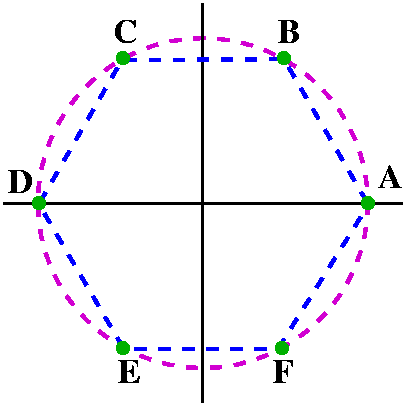 The picture to the right has the roots labeled A through F. These
complex numbers are the vertices of a regular hexagon (6-sided object)
centered at 0. What happens when we take powers of these roots?
(Notice that the modulus of all of them is 1, so that isn't involved
at all.)
The picture to the right has the roots labeled A through F. These
complex numbers are the vertices of a regular hexagon (6-sided object)
centered at 0. What happens when we take powers of these roots?
(Notice that the modulus of all of them is 1, so that isn't involved
at all.)
A·A=A (hey, A is just 1!).
B2=C ('cause we add the central angle of B to the central
angle of B!) and B3=D and B4=E and
B5=E and B6=1=A ('cause B is a sixth root
of 1!). So we get 6 distinct complex numbers.
C2=F, because twice 2Pi/3 (that's C's central angle, a value of its argument) is 4Pi/3. And then C3=A. Indeed. There are only 3 distinct powers of C.
D2=A (uhhhhh (-1)2=+1!) and therefore there are
only 2 distinct powers of D.
The qualitative behavior of E resembles that of D (three distinct
powers) and F's behavior resembles B,s: six distinct powers.
There is a great deal going on in this picture, much more than
is immediately evident. For those who have some algebra background:
the set {A,B,C,D,E,F} is a copy of the cyclic group of order 6,
and B and F are the only generators (that is, the only elements whose
powers get the whole group).
In general, there are actually n "nth roots of 1"
(classical phrase: nth roots of unity). There are
some special roots (called primitive roots) whose powers
generate all of the roots. This would all be too terribly abstract
except for the fact that knowing the structure of these roots really
well turns out to be important in such applications are cryptography,
signal processing, and fast Fourier transforms. Ain't that cute?
General fact about zn=w
If w is not 0, then the equation zn=w has n distinct
roots. The roots are a regular n-gon (n equal-sided polygon) centered
at 0. The "first" root is at arg(w)/n, and established the tilt (?) of
the polygon with respect to the positive real axis.
History, and what will happen in the course
One of the big discoveries (say, 1780 to 1810) of the theory is that
every polynomial equation with complex coefficients (degree>0,
of course!) has at least one root. Then ("high school algebra" -- we
will discuss this in detail) implies that there are the correct number
of roots. So we have found the roots explicitly for the equation
zn=w. In general, there will not be an explicit formula,
but there are algorithms which approximate these roots as well as you
might like.
My dog Ralph
Suppose I walk my dog Ralph at night. At a certain time, I am standing
30 feet from the street light, and the leash is 10 feet long. How
close can Ralph be to the light, and how far away can Ralph be?
Comments I think you can answer this by "pure thought" but I
want to get an algebraic method for handling this question, since we
will need to do more intricate computations of this type. And later in
the course we will be dealing with a dynamic (kinetic?) version of
this sort of question: I will be walking around the street, and the
leash length will be changing with time, etc. So we'll need to be a
bit careful.
The triangle inequality
If z and w are complex numbers, then |z+w|<=|z|+|w|. The
proof I gave of this was an exercise in using the summary of facts
which began the class. In fact, the principal reason I gave the proof
(proofs are not my chief objective in this class!) is to
perform an extended exercise using the facts, to help you get familiar
with them. The proof is in the text, and it goes something like this:
|z+w|2=(z+w)(z+w)–=zz–+zw–+z–w+ww–
("expand" the product). But zz–=|z|2 and
ww–=|w|2. Also, z–w=(zw–)–
because (z–)–=z and because conjugates
multiply. So the two terms zw–+z–w are actually
zw–+(zw–)– which is 2Re(zw–). But
2Re(zw–)<=2|zw–|=2|z| |w–|=2|z| |w|
(look again at the summary, please!). Therefore
|z+w|2<=|z|2+2|z| |w|+|w|2=(|z|+|w|)2. Take
square roots and get the triangle inequality. (I could never get this
wrong. I couldn't. I couldn't. More than 50% of the time, anyway.)
Ralph and me
If z represents me and the origin is the light, then |z|=30. If w
represents Ralph's position relative to me, then |w|<=10 (well, the
leash doesn't have to be stretched tightly!). So
|z+w|<=30+10=40. Ralph is at most 40 feet from the light.
Comment I do not claim this particular computation is profound!
Indeed, besides "pure thought" it is my expectation that anyone who
has worked with vectors can really see this several other ways. This
is one way of doing the computation -- that's all.
Reverse?
We can get an underestimate. |z|=|(z+w)-w|<=|z+w|+|w|, so that
|z|-|w|<=|z+w| (I will call this the Reverse Triangle
Inequality). If we now go back to Ralph and me, we know that
|w|<=10, so -|w|>=-10. Therefore |z|-|w|>=|z|-10. Since
|z|=30, we see that |z+w|>=|z|-|w|>=30-10=20. Ralph can't get
closer than 20 feet to the light under these circumstances.
I also mentioned that we could interchange z and w (I become Ralph and
Ralph walks me?). Then if |z|<=10 and |w|=30, we will see that
|z+w|>=|z|-|w|=|z|-30, and we get |z+w|>a negative
number! Well, this is certainly true (|z+w| is always non-negative!)
but it provides no information. So sometimes we need to be careful if
we want to get information.
|
I'll use this background color to indicate something that really is
not part of the course. I did mention this, so I would like to discuss
it very briefly.
Inequalities and complex numbers
The real numbers are what's called an ordered field. It has a
collection of positive numbers. In Math 311 the rules for manipulating
such things are investigated. These assumptions are usually made:
- A number v is 0 or positive or negative and exactly one of
these is true!
- Products and sums of positive numbers are positive.
Then using these rules the following facts are deduced (take 311 to
see this in more detail, please):
-
If v is positive, then -v is negative. Since if -v=0, v would have to
be 0 (contradiction); if -v were positive, v+(-v)=0 would be positive
(contradiction).
-
If v is positive, then v2=v·v is positive. (That's
immediate from the second assumption.)
-
Since 1=(-1)2, 1 must be positive (if 1 is not positive,
well, it isn't 0, and then -1 would be positive [??!!] so that its
square, 1, would be positive, contradiction.)
-
Therefore -1 is negative.
-
Non-zero squares are positive, since v>0 implies v2>0
and -v<0 implies v>0 (as above) so
(-v)2=((-1)v)2=1·v2 is
positive.
Suppose there is some sense of "positive" for complex numbers. What
can you say about i? If i were positive, then i2 would be
positive, but that's -1 and -1 is negative. But if i were negative,
then (-i)2=-1 would be positive: also impossible. Therefore
there is no way of ordering C.
As I remarked in class, as soon as I see something like (3+5i)>0 or
z<0 I know that I can stop reading: the reasoning makes no sense!
|
Exercise 1
If |z|=1, find useful over- and under-estimates of
|z5+z+7|.
How to do it Certainly I haven't
defined "useful" in this context, and we won't see the real uses of
the estimations for a few weeks. But let me show the techniques that
are usually tried first. They almost always involve the Triangle
Inequality and the Reverse Triangle Inequality. So:
|z5+z+7|<=|z5|+|z|+|7|=|z|5+|z|+7=1+1+7=9.
So we have an over-estimate.
How about the other side? Here 7 seems to be a good candidate for
BIG. Therefore
|7|-|z5+z|<=|z5+z+7|. Now
the largest that |z5+z| can be is 2 (again using the
Triangle Inequality). Therefore the smallest that
|7|-|z5+z| can be is 7-2=5.
The simple estimates are: if |z|=1, then 5<=|z5+z+7|<=9.
Exercise 2
If |z|=2, find useful over- and under-estimates of
|z5+z+7|.
How to do it I changed the modulus of
z. The over-estimate part works much the same:
|z5+z+7|<=|z5|+|z|+|7|=|z|5+|z|+7=32+2+7=41.
But for the under-estimate, the BIG term now seems to be
z5. Therefore
|z5|-|z+7|<=|z5+z+7|. Here
|z5|=|z|5=35, and the largest that |z+7| can be
when |z|=2 is 9. Therefore 35-9<=|z5+z+7|.
The simple estimates are: if |z|=2, then
26<=|z5+z+7|<=41.
| Wednesday,
January 23 | (Lecture #1) |
|---|
The information sheet was distributed,
so the students are now known.
Here are some problems which the techniques of this course can
investigate or solve or compute efficiently.
 The function arctan(x) has a graph which is very nice, a smooth
strictly increasing curve through the origin. Also, we know from calc
2 that the Taylor series of arctan centered at the origin is
The function arctan(x) has a graph which is very nice, a smooth
strictly increasing curve through the origin. Also, we know from calc
2 that the Taylor series of arctan centered at the origin is  n=0
n=0 (-1)nx2n+1/(2n+1). The radius of
convergence of this series is 1. What the heck goes wrong when
x-->1-1 (or maybe x-->1+)? Is there some
invisible flaw in the function or tiny "kink" in the graph which
causes a problem? What is happening?
(-1)nx2n+1/(2n+1). The radius of
convergence of this series is 1. What the heck goes wrong when
x-->1-1 (or maybe x-->1+)? Is there some
invisible flaw in the function or tiny "kink" in the graph which
causes a problem? What is happening?
- There are many techniques for solving differential equations, and
we have several courses devoted to these techniques. One method is to
transform the equation using the Laplace transform or the
Fourier transform, and then analyze the result. Part of the resulting
computational "baggage" is computing specific definite integrals. For
example, the following improper definite integral,
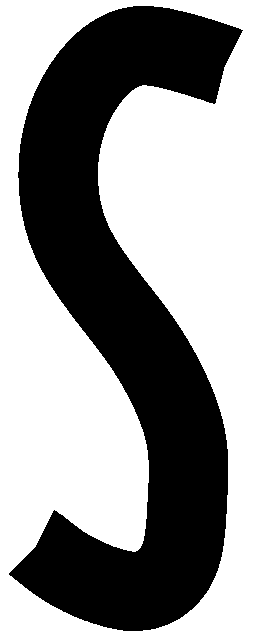 -
-
 [cos(mx)/(1+x2)]dx
[cos(mx)/(1+x2)]dx
(here m is an arbitrary
real parameter) comes up when computing Fourier transforms. The
definite integral converges because the top is between -1 and +1, and
the bottom, which is never 0, decays like 1/|x|2 when
|x|--> . In practice the exact
value of this integral is needed. Most standard computer algebra
systems (surely Maple or Mathematica) can give a (remarkably!) simple
answer. How do they do it? If you think about some of the standard
"tricks" to compute integrals (integration by parts? substitution?)
you would probably realize that they are inappropriate in this
case. How do these programs compute the integral? How difficult is it
and can this computation be done "by hand"?
. In practice the exact
value of this integral is needed. Most standard computer algebra
systems (surely Maple or Mathematica) can give a (remarkably!) simple
answer. How do they do it? If you think about some of the standard
"tricks" to compute integrals (integration by parts? substitution?)
you would probably realize that they are inappropriate in this
case. How do these programs compute the integral? How difficult is it
and can this computation be done "by hand"?
- One of the very classical models of many physical situations
involves the following partial differential equation:
 h=
h=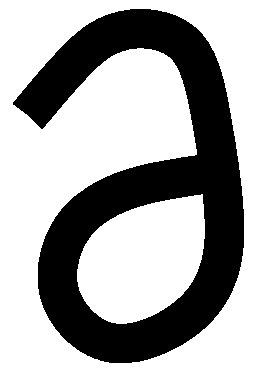 2h/
2h/ x2+
x2+ 2h/
2h/ y2=0. One phenomenon (among many) which this
models is "steady state heat flow in an isotropic medium": that is,
say, a thin metal plate where a boundary temperature is prescribed and
the temperature inside the plate doesn't change with time. A solution
of the differential equation is called a harmonic function. The
combination of the differential equation (Laplace's equation) and the
boundary condition is called the Dirichlet problem. It turns
out that, under fairly mild assumptions, there is a unique solution to
the Dirichlet problem. Maybe this is not obvious, but the way to
convince yourself that this is true is to start heating or cooling the
edge of a plate, and just let the heat "propagate" until an
equilibrium is reached. The same partial differential equation also
models other phenomena. O.k.: there is a solution. But how can
we actually find or compute the solution?
y2=0. One phenomenon (among many) which this
models is "steady state heat flow in an isotropic medium": that is,
say, a thin metal plate where a boundary temperature is prescribed and
the temperature inside the plate doesn't change with time. A solution
of the differential equation is called a harmonic function. The
combination of the differential equation (Laplace's equation) and the
boundary condition is called the Dirichlet problem. It turns
out that, under fairly mild assumptions, there is a unique solution to
the Dirichlet problem. Maybe this is not obvious, but the way to
convince yourself that this is true is to start heating or cooling the
edge of a plate, and just let the heat "propagate" until an
equilibrium is reached. The same partial differential equation also
models other phenomena. O.k.: there is a solution. But how can
we actually find or compute the solution? 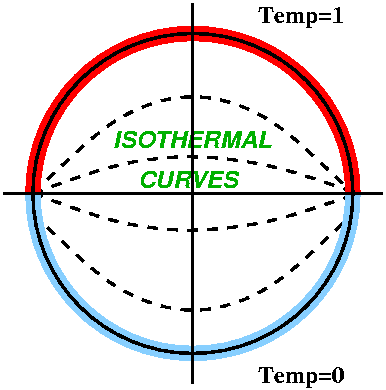 For example, we
could "prescribe" the boundary temperature on the unit disc. One
(seeming!) very simple boundary distribution might be temperature=1 on
the upper half of the boundary, and temperature=0 on the lower half of
the boundary. If then we want an equilibrium temperation distribution
on the inside of a disc-shaped plate, my guess is that the inside
temperature will be between 0 and 1 (hey, if a point inside had
temperature 150, I bet it would leak lots of heat to the boundary). I
also think that the symmetry of the boundary temperature would result
in symmetric isothermal curves inside the disc. O.k.: I can do this
much by "pure thought", but how can I now actually compute the inside
temperature? What are those curves?
For example, we
could "prescribe" the boundary temperature on the unit disc. One
(seeming!) very simple boundary distribution might be temperature=1 on
the upper half of the boundary, and temperature=0 on the lower half of
the boundary. If then we want an equilibrium temperation distribution
on the inside of a disc-shaped plate, my guess is that the inside
temperature will be between 0 and 1 (hey, if a point inside had
temperature 150, I bet it would leak lots of heat to the boundary). I
also think that the symmetry of the boundary temperature would result
in symmetric isothermal curves inside the disc. O.k.: I can do this
much by "pure thought", but how can I now actually compute the inside
temperature? What are those curves?
There are a number of ways of investigating all three of these
situations, because they are important problems and many clever people
have looked at them. But most knowledgeable people would agree that
first way to consider the problems is to use "calculus with complex
numbers". And all three of these problems, which I admit I selected
for their seeming dissonance, are closely related. They can all be
very profitably understood using this complex analysis.
Just as in real calculus the variable is usually called x, in complex
analysis we call "the" variable is usually called z. And, just to
quiet speculation, the following equation is true:
d
---(z5)=5z4
dz
The elementary computational algorithms will all be unchanged: that's
easy. What turns out to be significant is what d/dz means. And
the results of that consideration make complex analysis in some
fundamental way much easier then real analysis but also very
different.
Introducing the main characters
The plane is a wonderful geometric object, and it can be thought about
in many different ways. Let me consider three of them.
- Two dimensional vectors: forces or velocities or ... So these
are arrows with a head and a tail. They are directed line segments and
the length is the magnitude, etc. They can be added by putting head to
tail, etc. So then every vector can be written as a sum of i
and j and ...
- R2: by this I mean the collection of all ordered pairs
(a,b), with a and b real numbers. We meet this formulation (hey: the
two-dimensional real vector space: formidable language!) for
example in linear algebra, where we learn to manipulate vectors
(actually in any dimension) using row reducation. We can multiply
vectors by scalars, add them, etc.
- The plane is also C, the complex numbers. Here I think of
a+bi (with a and b real) as a number, and I will assume that
i2=-1. Then I will try to follow my nose (?) and compute
with these things.
All three of these labelings really will refer to the same geometric
object, the plane. I can switch my point of view from one to the
other, whatever is convenient. So the vector ai+bj will
be the same as the ordered pair (a,b) will be the same as the complex
number a+bi.
What's a field?
To me, all of linear algebra is one algorithm plus lots of
definitions. Of course, this is a simplification, but not a huge
one. The algorithm has various names: I usually think of it as row
reduction. The definitions help us understand how to cope with the
information going in and out of the algorithm. To "run" row reduction,
we need to be able to add and multiply and to subtract and divide and
... Well, here are the organizing principles which seem to be
necessary.
Addition Addition is commutative and associative; there is an
additive identity and there are additive inverses.
Commutative means that the order of
addition doesn't matter: 3+7=7+3. Associative means that the
grouping doesn't matter: 3+(7+4)=(3+7)+4. The additive identity
means there is a number 0 so that 7+0=7 (for "all values of 7"). And
of course additive inverse means that there is a number -7 so
that 7+(-7)=0.
Multiplication Multiplication is commutative and associative;
there is an multiplicative identity and (for non-zero numbers!) there
are multiplicative inverses.
The words have meanings similar to what they mean for
addition. The only interesting variation is that 0 can't have a
multiplicative inverse ("You can't divide by 0.") because people
learned this was necessary to avoid some serious logical and
computational problems.
Distributivity (linking + and x) a(b+c)=ab+ac.
These "rules" are all that is necessary to do a very wide variety
of computation.
A very tiny field
0 (the additive identity) and 1 (the multiplicative identity) had
better be different. But just with those two numbers there is
enough to do arithmetic. What follows are tables defining addition and
multiplication. Certainly a century ago this was merely a mathematical
curiosity.
+ | 0 | 1 + | 0 | 1
----------- -----------
0 | 0 | 1 0 | 0 | 0
----------- -----------
1 | 1 | 0 1 | 0 | 1
Now we recognize that the tables in fact are vital to understanding Boolean
expressions (true/false) and the linear algebra algorithm is very useful
in analyzing complicated "statements". This field is called Z2.
I want to consider more natural (?) fields.
The field we grew up with
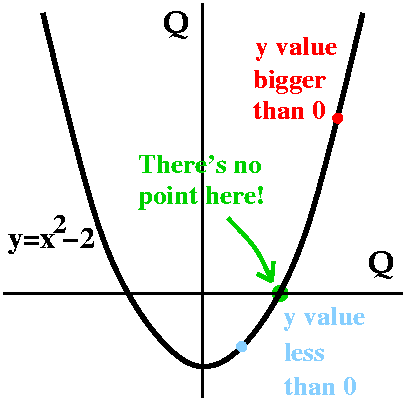 I want to count: 1, 2, 3, 4, 5, .... and divide up pies (half a pie or
a quarter of a pie for me, and a tenth of a pie for you). So we are
led to the rational numbers, Q, a very natural field. I like this
field. With patience, I can even compute moderately efficiently with
it. However, there is something wrong with it: a lack of
completeness which is upsetting to our intuition.
I want to count: 1, 2, 3, 4, 5, .... and divide up pies (half a pie or
a quarter of a pie for me, and a tenth of a pie for you). So we are
led to the rational numbers, Q, a very natural field. I like this
field. With patience, I can even compute moderately efficiently with
it. However, there is something wrong with it: a lack of
completeness which is upsetting to our intuition.
Very frequently people are treated to the proof that the square root
of 2 is irrational. Well, I think the proof really says the following:
there is no rational number whose square is 2. Maybe that's not
surprising. But let's recast it. Consider the graph of
y=x2-2 on the rational
plane. That is, we only look at points whose coordinates are
rational. There are lots and lots of rationals, so I bet that the
graph looks like what is drawn to the right (heck, the picture and web
browser actually use finite field algorithms, not even rational
algorithms!). Since no rational number has square equal to 2, the
curve can't intersect the horizontal axis. But look: the graph has
points above the axis and points below the axis. So it magically (?)
goes from below to above without hitting the axis. This is the
upsetting part.
Completing that one
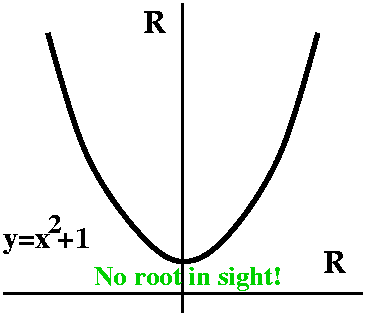 If you want
to have enough numbers so that things intersect correctly you
need the real field. That's the one with all possible decimal
expansions. We have a course (Math 311) mostly devoted to proving everything you'd
want to know about the real numbers using this completeness
assumption. So I don't need to do anyting about it. But, sigh, there
is something even simpler that's still wrong. In high school we learn
that polynomials should have roots. So the embarrassment of
x2-2 is dealt with by assuming completeness (the parabola
and the line should intersect!). But a more obvious flaw is
that x2+1 which should clearly (?) have two roots
doesn't have any at all!
If you want
to have enough numbers so that things intersect correctly you
need the real field. That's the one with all possible decimal
expansions. We have a course (Math 311) mostly devoted to proving everything you'd
want to know about the real numbers using this completeness
assumption. So I don't need to do anyting about it. But, sigh, there
is something even simpler that's still wrong. In high school we learn
that polynomials should have roots. So the embarrassment of
x2-2 is dealt with by assuming completeness (the parabola
and the line should intersect!). But a more obvious flaw is
that x2+1 which should clearly (?) have two roots
doesn't have any at all!
Correcting the flaw
So the complex numbers, C, correct the flaw. In C, x2+1 (or
z2+1, to use the variable name which is more common) has
two roots, +/-i.
Arithmetic in C
I want to be sure that we can do arithmetic in C. So let me write how
to add and multiply complex numbers.
Suppose z=a+bi and w=c+di. Then:
Addition z+w=(a+c)+(b+d)i. (This is exactly the old
"head-to-tail" definition of vector addition. Good: less need to
enlarge the brain.)
Multiplication Well, if we just try to compute
(a+bi)(c+di) and assume everything will work (distribute, use
i2=-1, etc.), then zw=(ac-bd)+(ad+bc)i. So that's our
definition.
Verification of the field rules in C (eh)
Clearly these rules make C into a field. Well,
maybe not clearly. But I am lazy and verification that C is a field is
tedious. There is one aspect that takes some thinking, so let me
address it, and that's the existence of multiplicative inverses. I
want to show you that if a+bi is not the 0 complex number
(0+0i) then there is another complex number whose product with this
one gives me 1 (1+0i). Here is a way to think about it:
1 1 (a-bi) a-bi a-bi
----- = ----- · -------- = ------------ = ------
a+bi a+bi (a-bi) (a+bi)(a-bi) a2+b2
So now I guess that if w=(a/[a2+b2])-(b/[a2+b2])i then the product of z and w will be 1.
Indeed,
a(a/[a2+b2])–b·{-(b/[a2+b2])}=[a2+b2]/[a2+b2]=1
(that's the first part of the product) and
a(-b/[a2+b2])+b·(a/[a2+b2])=[a2+b2]/[a2+b2]=0
(that's the second part of the product).
Notice, please, that the above computation is successful exactly when
the number a2+b2 is not 0, and this is
exactly when the complex number a+bi is not the 0 complex number,
0+0i.
A sane person might ask what is going on here. Well, my primary answer
would be, "It works, doesn't it?" If that is not satisfactory to you,
then there are a large number of detours I could suggest (study some
algebra -- for example, Math 451-452). But for this course, I will try
to make believability arguments (heuristic discussions). This is
actually how things grew historically.
Vocabulary and pictures
Almost everything that "accidentally" got written above turns out to
have a special name. So if z=a+bi:
- a is called the real part of z, and we write a=Re(z).
- b is called the imaginary part of z, and we write b=Im(z).
 The number sqrt(a2+b2) is written |z|, and
is called (variously) the modulus of z, the norm of
z. the magnitude of z ... I'll probably just use the first word
most of the time. The reason to think about the square root instead of
what's inside is because of the picture to the right.
The number sqrt(a2+b2) is written |z|, and
is called (variously) the modulus of z, the norm of
z. the magnitude of z ... I'll probably just use the first word
most of the time. The reason to think about the square root instead of
what's inside is because of the picture to the right.
Note Square roots are at the core of a great deal of difficulty
in this subject. Right now I will only use sqrt to mean the following:
if V is a non-negative real number then sqrt(V) will mean the
unique non-negative real number which, when multiplied by
itself (its square) gives V. I'll work more diligently to discuss how
we should think about other square roots.
- a-bi is called the complex conjugate of z, and is written z
with a bar over it (in html I will write z–) and we
sometimes say z-bar. Geometrically, z– is the
reflection of z in the horizontal axis.
Relabeling the pictures
 Let's draw things a bit differently and get a polar
representation of z. Then we get the interesting formula
Let's draw things a bit differently and get a polar
representation of z. Then we get the interesting formula
z=r(cos( )+i sin(
)+i sin( )) (somehow I usually write
the i before the sine)
)) (somehow I usually write
the i before the sine)
Here r is the modulus, and  is
called the argument of z. And now we are in a great deal of
trouble, because of "the". Actually, there are many arguments which
are valid. We only need the information contained in the values of
sine and cosine of
is
called the argument of z. And now we are in a great deal of
trouble, because of "the". Actually, there are many arguments which
are valid. We only need the information contained in the values of
sine and cosine of  , so
arguments are really only defined up to a multiple of 2Pi.
, so
arguments are really only defined up to a multiple of 2Pi.
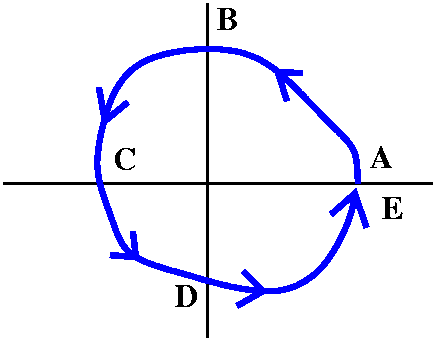 The difficulty
is actually fundamental. Let me show you: let's start with a point on
the positive real axis, A. I guess I could have its argument be
0. Then let us travel around towards B. If I want the argument to
move or vary continuously, then I think that B's
argument should be Pi/2. Now let's go to C on the path shown. C is on
the negative real axis, and, to keep things nice, it should have
argument Pi. Of course we will move on to D, which should have
argument 3Pi/2. Now creep very slowly to E, and E itself is darn close
to A. Well, I bet that E's argument, if we want things to vary
continuously, should be nearly 2Pi. But ... but ... if we let E move
to coincide with A, then what should the argument be? Is it 0 or 2Pi?
Have we somehow made a mistake? Not at all: this is part of what we
need to explain. If we want to have a continuous argument, then we
will have to agree that argument is defined only up to integer
multiples of 2Pi (as math folks might say, "mod 2Pi"). This will come
up again below in a more algebraic context. This is a serious
complication which won't go away.
The difficulty
is actually fundamental. Let me show you: let's start with a point on
the positive real axis, A. I guess I could have its argument be
0. Then let us travel around towards B. If I want the argument to
move or vary continuously, then I think that B's
argument should be Pi/2. Now let's go to C on the path shown. C is on
the negative real axis, and, to keep things nice, it should have
argument Pi. Of course we will move on to D, which should have
argument 3Pi/2. Now creep very slowly to E, and E itself is darn close
to A. Well, I bet that E's argument, if we want things to vary
continuously, should be nearly 2Pi. But ... but ... if we let E move
to coincide with A, then what should the argument be? Is it 0 or 2Pi?
Have we somehow made a mistake? Not at all: this is part of what we
need to explain. If we want to have a continuous argument, then we
will have to agree that argument is defined only up to integer
multiples of 2Pi (as math folks might say, "mod 2Pi"). This will come
up again below in a more algebraic context. This is a serious
complication which won't go away.
A wonderful computation
Complex number addition is just a rephrasing of the old
(2-dimensional) vector addition. Complex multiplication (with ac-bd
and ad+bc) seems more complicated. Let me show you a neat computation
that might help clarify what is going on.
Suppose z=r(cos( )+i sin(
)+i sin( )) and
w=s(cos(
)) and
w=s(cos(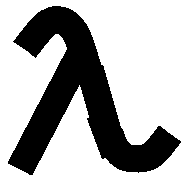 )+i sin(
)+i sin( )). Let's compute zw. We can do
this in any order (associativity) so that
)). Let's compute zw. We can do
this in any order (associativity) so that
zw=rs(cos( )+i sin(
)+i sin( ))(cos(
))(cos( )+i sin(
)+i sin( ))=rs(cos(
))=rs(cos( )cos(
)cos( )-sin(
)-sin( )(
)( )+i cos(
)+i cos( )sin(
)sin( )+sin(
)+sin( )cos(
)cos( )).
)).
We accidentally recognize certain things. (In fact, there aren't any
accidents. Later you will see why these computations work as they do.).
zw=rs(cos( +
+ )+i sin(
)+i sin( +
+ )). Well, cos(thing)+i sin(thing) always has
modulus 1 (because sin2+cos2=1). So:
)). Well, cos(thing)+i sin(thing) always has
modulus 1 (because sin2+cos2=1). So:
The consequences
The modulus of the product is the product of the moduli: |zw|=|z||w|.
The argument of the product is the sum of the
arguments.
But as I pointed out even this has some difficulties. I know that:
i2=-1, and i3=-i, and i4=1.
If we take arg(i) to be Pi/2, then arg(i2)=2(Pi/2)=Pi and
arg(i3)=3(Pi/2)=3Pi/2 and arg(i4)=4(Pi/2)=2Pi,
which might contrast interestingly with a naive value of
arg(i4)=arg(1)=0. So 0=2Pi? Well, "mod 2Pi" or, up to an
integer multiple of 2Pi, that's true. We need to keep this in mind. It
will come up again and again.
DeMoivre's Theorem
If n is an integer, (cos( )+i sin(
)+i sin( ))n=cos(n
))n=cos(n )+i sin(n
)+i sin(n ).
).
Next time we'll investigate a few interesting consequences of this
theorem. The result is true because we just add n  's together when we take
nth powers of cos(
's together when we take
nth powers of cos( )+i sin(
)+i sin( ).
).
Maintained by
greenfie@math.rutgers.edu and last modified 1/24/2008.



















 One geometric way to visualize what is going on uses stereographic
projection. Put the complex plane into space (R3) as
the xy-plane, with third coordinate equal to 0. Draw a sphere with
radius 1 and center the origin, (0,0,0). Let N, the North Pole, be
located at (0,0,1). Then every point a on the sphere which isn't N
corresponds to a unique point b on the complex plane. The
correspondance is by drawing a line from N to a and extending it until
it intersects the plane. The intersection point is called b. Of
course, we could start with b on the complex plane, and connect it
with N, and the line would always hit the sphere in some other point,
a. This "correspondance" is a useful thing to keep in the back of your
mind (?) throughout your study of the subject. Of course you can write
lots and lots of equations describing everything, but right now I just
want the idea, without proofs or whatever. In fact, it turns out that
stereographic project also "preserves angles" between corresponding
curves (this is not immediately obvious at all).
One geometric way to visualize what is going on uses stereographic
projection. Put the complex plane into space (R3) as
the xy-plane, with third coordinate equal to 0. Draw a sphere with
radius 1 and center the origin, (0,0,0). Let N, the North Pole, be
located at (0,0,1). Then every point a on the sphere which isn't N
corresponds to a unique point b on the complex plane. The
correspondance is by drawing a line from N to a and extending it until
it intersects the plane. The intersection point is called b. Of
course, we could start with b on the complex plane, and connect it
with N, and the line would always hit the sphere in some other point,
a. This "correspondance" is a useful thing to keep in the back of your
mind (?) throughout your study of the subject. Of course you can write
lots and lots of equations describing everything, but right now I just
want the idea, without proofs or whatever. In fact, it turns out that
stereographic project also "preserves angles" between corresponding
curves (this is not immediately obvious at all).







 So we have
three distinct roots of the equation z3=1, and they form an
equilateral triangle centered around 0. I asked if we could get roots
of z3=2, say. After some thought, we decided that we knew
one "real" root, 21/3, and then we can get others. A
complete set of roots turns out to be 21/3r0 and
21/3r1 and 21/3r2. This is
also an equilateral triangle around 0. To the right is a picture of
them. The real number whose cube is 2 is about 1.26, so the unit
circle is inside the "radius" of all of the roots of 2.
So we have
three distinct roots of the equation z3=1, and they form an
equilateral triangle centered around 0. I asked if we could get roots
of z3=2, say. After some thought, we decided that we knew
one "real" root, 21/3, and then we can get others. A
complete set of roots turns out to be 21/3r0 and
21/3r1 and 21/3r2. This is
also an equilateral triangle around 0. To the right is a picture of
them. The real number whose cube is 2 is about 1.26, so the unit
circle is inside the "radius" of all of the roots of 2.
 Finally I
asked if we could "solve" z3=1+i. Well, in polar form 1+i
is sqrt(2)(cos(Pi/4)+i sin(Pi/4)). I will guess (not
really -- I am being guided by previous computations) one cube root of
1+i. If z=r(cos(
Finally I
asked if we could "solve" z3=1+i. Well, in polar form 1+i
is sqrt(2)(cos(Pi/4)+i sin(Pi/4)). I will guess (not
really -- I am being guided by previous computations) one cube root of
1+i. If z=r(cos( The picture to the right has the roots labeled A through F. These
complex numbers are the vertices of a regular hexagon (6-sided object)
centered at 0. What happens when we take powers of these roots?
(Notice that the modulus of all of them is 1, so that isn't involved
at all.)
The picture to the right has the roots labeled A through F. These
complex numbers are the vertices of a regular hexagon (6-sided object)
centered at 0. What happens when we take powers of these roots?
(Notice that the modulus of all of them is 1, so that isn't involved
at all.)
 The function arctan(x) has a graph which is very nice, a smooth
strictly increasing curve through the origin. Also, we know from calc
2 that the Taylor series of arctan centered at the origin is
The function arctan(x) has a graph which is very nice, a smooth
strictly increasing curve through the origin. Also, we know from calc
2 that the Taylor series of arctan centered at the origin is  For example, we
could "prescribe" the boundary temperature on the unit disc. One
(seeming!) very simple boundary distribution might be temperature=1 on
the upper half of the boundary, and temperature=0 on the lower half of
the boundary. If then we want an equilibrium temperation distribution
on the inside of a disc-shaped plate, my guess is that the inside
temperature will be between 0 and 1 (hey, if a point inside had
temperature 150, I bet it would leak lots of heat to the boundary). I
also think that the symmetry of the boundary temperature would result
in symmetric isothermal curves inside the disc. O.k.: I can do this
much by "pure thought", but how can I now actually compute the inside
temperature? What are those curves?
For example, we
could "prescribe" the boundary temperature on the unit disc. One
(seeming!) very simple boundary distribution might be temperature=1 on
the upper half of the boundary, and temperature=0 on the lower half of
the boundary. If then we want an equilibrium temperation distribution
on the inside of a disc-shaped plate, my guess is that the inside
temperature will be between 0 and 1 (hey, if a point inside had
temperature 150, I bet it would leak lots of heat to the boundary). I
also think that the symmetry of the boundary temperature would result
in symmetric isothermal curves inside the disc. O.k.: I can do this
much by "pure thought", but how can I now actually compute the inside
temperature? What are those curves?
 I want to count: 1, 2, 3, 4, 5, .... and divide up pies (half a pie or
a quarter of a pie for me, and a tenth of a pie for you). So we are
led to the rational numbers, Q, a very natural field. I like this
field. With patience, I can even compute moderately efficiently with
it. However, there is something wrong with it: a lack of
completeness which is upsetting to our intuition.
I want to count: 1, 2, 3, 4, 5, .... and divide up pies (half a pie or
a quarter of a pie for me, and a tenth of a pie for you). So we are
led to the rational numbers, Q, a very natural field. I like this
field. With patience, I can even compute moderately efficiently with
it. However, there is something wrong with it: a lack of
completeness which is upsetting to our intuition.
 If you want
to have enough numbers so that things intersect correctly you
need the real field. That's the one with all possible decimal
expansions. We have a course (Math 311) mostly devoted to proving everything you'd
want to know about the real numbers using this completeness
assumption. So I don't need to do anyting about it. But, sigh, there
is something even simpler that's still wrong. In high school we learn
that polynomials should have roots. So the embarrassment of
x2-2 is dealt with by assuming completeness (the parabola
and the line should intersect!). But a more obvious flaw is
that x2+1 which should clearly (?) have two roots
doesn't have any at all!
If you want
to have enough numbers so that things intersect correctly you
need the real field. That's the one with all possible decimal
expansions. We have a course (Math 311) mostly devoted to proving everything you'd
want to know about the real numbers using this completeness
assumption. So I don't need to do anyting about it. But, sigh, there
is something even simpler that's still wrong. In high school we learn
that polynomials should have roots. So the embarrassment of
x2-2 is dealt with by assuming completeness (the parabola
and the line should intersect!). But a more obvious flaw is
that x2+1 which should clearly (?) have two roots
doesn't have any at all!
 The difficulty
is actually fundamental. Let me show you: let's start with a point on
the positive real axis, A. I guess I could have its argument be
0. Then let us travel around towards B. If I want the argument to
move or vary continuously, then I think that B's
argument should be Pi/2. Now let's go to C on the path shown. C is on
the negative real axis, and, to keep things nice, it should have
argument Pi. Of course we will move on to D, which should have
argument 3Pi/2. Now creep very slowly to E, and E itself is darn close
to A. Well, I bet that E's argument, if we want things to vary
continuously, should be nearly 2Pi. But ... but ... if we let E move
to coincide with A, then what should the argument be? Is it 0 or 2Pi?
Have we somehow made a mistake? Not at all: this is part of what we
need to explain. If we want to have a continuous argument, then we
will have to agree that argument is defined only up to integer
multiples of 2Pi (as math folks might say, "mod 2Pi"). This will come
up again below in a more algebraic context. This is a serious
complication which won't go away.
The difficulty
is actually fundamental. Let me show you: let's start with a point on
the positive real axis, A. I guess I could have its argument be
0. Then let us travel around towards B. If I want the argument to
move or vary continuously, then I think that B's
argument should be Pi/2. Now let's go to C on the path shown. C is on
the negative real axis, and, to keep things nice, it should have
argument Pi. Of course we will move on to D, which should have
argument 3Pi/2. Now creep very slowly to E, and E itself is darn close
to A. Well, I bet that E's argument, if we want things to vary
continuously, should be nearly 2Pi. But ... but ... if we let E move
to coincide with A, then what should the argument be? Is it 0 or 2Pi?
Have we somehow made a mistake? Not at all: this is part of what we
need to explain. If we want to have a continuous argument, then we
will have to agree that argument is defined only up to integer
multiples of 2Pi (as math folks might say, "mod 2Pi"). This will come
up again below in a more algebraic context. This is a serious
complication which won't go away.